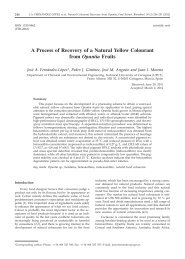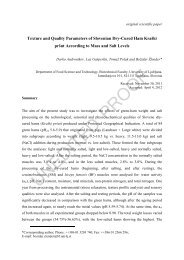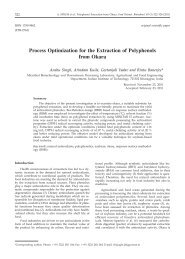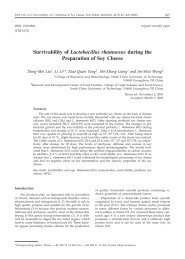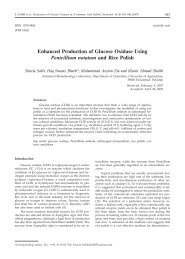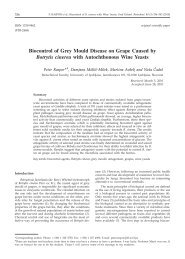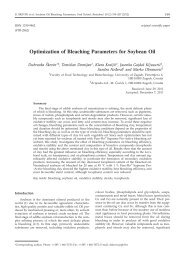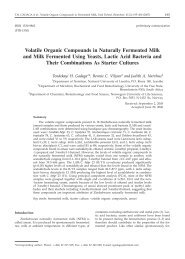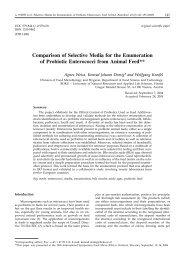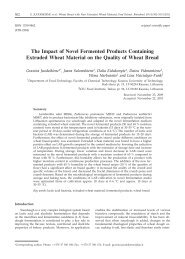Aerobic Degradation of Formaldehyde in Wastewater - Food ...
Aerobic Degradation of Formaldehyde in Wastewater - Food ...
Aerobic Degradation of Formaldehyde in Wastewater - Food ...
You also want an ePaper? Increase the reach of your titles
YUMPU automatically turns print PDFs into web optimized ePapers that Google loves.
M. GLANCER-[OLJAN et al.: <strong>Aerobic</strong> <strong>Degradation</strong> <strong>of</strong> <strong>Formaldehyde</strong> <strong>in</strong> <strong>Wastewater</strong>, <strong>Food</strong> technol. biotechnol. 39 (3) 197–202 (2001)197UDC 547.281.1:582.231:628.54ISSN 1330–9862orig<strong>in</strong>al scientific paper(FTB-1078)<strong>Aerobic</strong> <strong>Degradation</strong> <strong>of</strong> <strong>Formaldehyde</strong> <strong>in</strong> <strong>Wastewater</strong> fromthe Production <strong>of</strong> Melam<strong>in</strong>e Res<strong>in</strong>sMargareta Glancer-[oljan 1* , Vice [oljan 2 ,Tibela Landeka Dragi~evi} 1 and Ljiljana ^a~i} 31 Faculty <strong>of</strong> <strong>Food</strong> Technology and Biotechnology, University <strong>of</strong> Zagreb,Pierottijeva 6, P.O.B. 625, HR-10 000 Zagreb, Croatia2 »Ekolo{ki <strong>in</strong>`enjer<strong>in</strong>g« d.o.o. Pore~, Ive Andri}a 76, HR-52 000 Pore~, Croatia3 »Ekolaboratorij«, Vodovod d.o.o. Osijek, Poljski put 1, HR-31 000 Osijek, CroatiaDedicated to the memory <strong>of</strong> Pr<strong>of</strong>essor Vera JohanidesReceived: March 15, 2001Accepted: June 20, 2001SummarySelected stra<strong>in</strong>s <strong>of</strong> Pseudomonas putida, Pseudomonas cepacia, Trichosporon penicillatumyeast and the mixed culture <strong>of</strong> these three stra<strong>in</strong>s were used for aerobic degradation <strong>of</strong>formaldehyde and formic acid <strong>in</strong> the synthetic medium and wastewater generated by melam<strong>in</strong>eres<strong>in</strong>s production. It has been shown that the mixed culture <strong>in</strong> the synthetic mediumdegrades 1000 mg/L <strong>of</strong> formaldehyde over 18–24 hours and 500 mg/L <strong>of</strong> formicacid over 12–18 hours. <strong>Aerobic</strong> degradation <strong>of</strong> wastewater from the production <strong>of</strong> melam<strong>in</strong>eres<strong>in</strong>s with the use <strong>of</strong> mixed bacterial and yeast culture was achieved <strong>in</strong> 24 hours withCOD reduction <strong>of</strong> over 90 % and complete degradation <strong>of</strong> formaldehyde, methanol andbutanol. The role <strong>of</strong> Trichosporon penicillatum yeast <strong>in</strong> the mixed culture, dur<strong>in</strong>g aerobic degradation<strong>of</strong> formaldehyde <strong>in</strong> the synthetic medium and wastewater, was to form flocculentbiomass that is self-precipitat<strong>in</strong>g.Key words: mixed culture <strong>of</strong> bacteria and yeast, aerobic degradation <strong>of</strong> formaldehyde,wastewater from production <strong>of</strong> melam<strong>in</strong>e res<strong>in</strong>sIntroduction<strong>Formaldehyde</strong> is used <strong>in</strong> <strong>in</strong>dustrial process<strong>in</strong>g <strong>of</strong>wood and <strong>in</strong> the production <strong>of</strong> paper, leather, res<strong>in</strong>s andglue (1). It occurs <strong>in</strong> wastewaters <strong>of</strong> various orig<strong>in</strong>s anddue to its biocidal action it is toxic to many microorganisms(2). It has been shown that formaldehyde is theproduct <strong>of</strong> biodegradation <strong>of</strong> C 1 -compounds, e.g. methaneand methanol, and <strong>of</strong> nitrogen compounds, where itis a key <strong>in</strong>termediate <strong>of</strong> degradation (3).Accord<strong>in</strong>g to scarce literature data the follow<strong>in</strong>g microorganismsare capable to degrade formaldehyde:Pseudomonas spp. generum (4), Halomonas spp. (5) andvarious stra<strong>in</strong>s <strong>of</strong> methylotropha (6); Debariomyces spp.and Trichosporon spp. yeast genera (7), Hansenula spp.(8), Candida spp. (9) and Gliocladium spp. fungi (10).Formic acid is the basic <strong>in</strong>termediate <strong>in</strong> formaldehydebiodegradation (3–6). Pseudomonas spp. degrade* Correspond<strong>in</strong>g author; E-mail: mglancer@pbf.hr; Phone: ++385 (0)1 4605 033; Fax: ++385 (0)1 4605 072
198 M. GLANCER-[OLJAN et al.: <strong>Aerobic</strong> <strong>Degradation</strong> <strong>of</strong> <strong>Formaldehyde</strong> <strong>in</strong> <strong>Wastewater</strong>, <strong>Food</strong> technol. biotechnol. 39 (3) 197–202 (2001)formaldehyde with formaldehyde dismutase enzyme(11) while a yeast, e.g. Hansenula spp. and Candida spp.genera, achieves it us<strong>in</strong>g the enzymes formaldehydeandformate dehydrogenase (9,10). The reactions are:Pseudomonas putida2HCHOformaldehyde dismutaCH3OH HCOOHseHansemula polymorfaorCandida boid<strong>in</strong>iiHCHO HCOOHCO 2formaldehydehydrogenaseformatedehydrogenaseNot many microorganisms can degrade formaldehyde,which is attributed to its toxic effect on various parts <strong>of</strong>bacterial cells such as spores, cell wall and compoundswith am<strong>in</strong>o-group.It has been shown that formaldehyde undergoesbiodegradation <strong>in</strong> synthetic media. There are, however,scarce reports on its degradation <strong>in</strong> wastewaters. Thiscan be expla<strong>in</strong>ed by the fact that, <strong>in</strong> addition to formaldehyde,wastewaters conta<strong>in</strong> other substances that mayaffect formaldehyde degradation. For example, wastewatersfrom the production <strong>of</strong> melam<strong>in</strong>e res<strong>in</strong>s do notconta<strong>in</strong> only formaldehyde (70–2700 mg/L), but alsomethanol (up to 300 mg/L), butanol (up to 200 mg/L)and melam<strong>in</strong>e (700–5000 mg/L) (13); wastewaters fromthe production <strong>of</strong> urea formaldehyde res<strong>in</strong>s conta<strong>in</strong> formaldehyde(200–4000 mg/L), urea (100–800 mg/L) andammonium (up to 400 mg/L) (14).The subject <strong>of</strong> this study was an aerobic degradation<strong>of</strong> formaldehyde <strong>in</strong> the synthetic medium, as wellas <strong>of</strong> wastewater from the production <strong>of</strong> melam<strong>in</strong>e res<strong>in</strong>s,us<strong>in</strong>g the mixed culture <strong>of</strong> two bacteria <strong>of</strong> Pseudomonasspp. genus and Trichosporon spp. yeast genus. Therole <strong>of</strong> each species is discussed on the basis <strong>of</strong> its action<strong>in</strong> the mixed culture.Material and MethodsMixed culture <strong>of</strong> microorganismsThe mixed culture used <strong>in</strong> the experiments on formaldehydedegradation conta<strong>in</strong>ed two bacteria <strong>of</strong> Pseudomonasgenerum – Pseudomonas putida LOV 400 and Pseudomonascepacia LOV 401, as well as <strong>of</strong> Trichosporongenerum – Trichosporon penicillatum LOV 200. (LOV =Collection <strong>of</strong> microorganisms at the Laboratory for biologicalwastewater treatment, Faculty <strong>of</strong> <strong>Food</strong> Scienceand Biotechnology, University <strong>of</strong> Zagreb).Synthetic medium and wastewaterThe synthetic medium was aqueous solution <strong>of</strong>formaldehyde (concentration <strong>of</strong> 1000 mg/L) with addition<strong>of</strong> 100–250 mg/L <strong>of</strong> (NH 4 ) 2 HPO 4 as the source <strong>of</strong>nitrogen and phosphorus.To test the activity <strong>of</strong> each component <strong>of</strong> the mixedculture used for degradation <strong>of</strong> formic acid as an <strong>in</strong>termediate<strong>of</strong> formaledhyde degradation, 500 mg/L <strong>of</strong> formicacid was added to the synthetic medium, <strong>in</strong>stead <strong>of</strong>formaldehyde, and adjusted pH by the addition <strong>of</strong> 2 MNaOH. Table 1 shows the composition <strong>of</strong> the wastewaterused <strong>in</strong> this work. The analyses <strong>of</strong> methanol,Table 1. Composition <strong>of</strong> wastewater from the production <strong>of</strong>melam<strong>in</strong>e res<strong>in</strong>sIngredients*<strong>Wastewater</strong>(formladehyde)/mg L-1 500 – 1000(methanol)/mg L-1 350 – 800(butanol)/mg L-1 150 – 400(res<strong>in</strong>s)/mg L-1 800 – 1500(COD)/mg L-1 1500 – 3500pH 7.7 – 8.0*Data refer to the sample <strong>of</strong> wastewater prepared by the treatment<strong>of</strong> the orig<strong>in</strong>al wastewater with lime and FeCl 3 30 % solutionto remove <strong>in</strong>soluble res<strong>in</strong>sbutanol and formic acid were performed <strong>in</strong> the Laboratory<strong>of</strong> »Melam<strong>in</strong>«-Ko~evje, Slovenia.Res<strong>in</strong>s <strong>in</strong> wastewater were melam<strong>in</strong>s that are knownto be hardly biodegradable (12,15). Nitrogen from melam<strong>in</strong>eis unavailable to microorganisms, therefore(NH 4 ) 2 HPO 4 had been added to wastewater as thesource <strong>of</strong> nitrogen and phosphorus. <strong>Wastewater</strong> hadbeen kept refrigerated at +4 °C.Preparation <strong>of</strong> <strong>in</strong>oculumP. putida, P. cepacia and yeast T. penicillatum stra<strong>in</strong>shad been kept refrigerated. Prior to the experiment, eachculture had been <strong>in</strong>oculated on the agar plates with theculture medium for bacterial growth conta<strong>in</strong><strong>in</strong>g (g/L):meat extract 3, bacto peptone 5, NaCl 5 and agar 25, andthe medium for yeast growth was prepared (g/L) <strong>of</strong>glucose 20, bacto peptone 10, yeast extract 5 and agar25. Incubation was carried out at 28 °C over 48–72 hours.Each culture was transferred from the plate to 1 Lserum bottle. Volume <strong>of</strong> the synthetic medium was 0.7 Lwith formaldehyde concentration <strong>of</strong> 50 mg/L. Similarprocedure was performed concomitantly with the syntheticmedium conta<strong>in</strong><strong>in</strong>g 50 mg/L <strong>of</strong> formic acid. Serumbottles were supplied with the aeration system.Growth <strong>of</strong> each culture had been monitored through thechange <strong>of</strong> absorbance (optical density, OD) at 610 nm (4)for bacteria and at 660 nm (7) for the yeast. Concentration<strong>of</strong> formaldehyde and formic acid was measured atstabilised levels <strong>of</strong> optical density.After adaption <strong>of</strong> each bacterial culture <strong>in</strong> the m<strong>in</strong>eralmedium with formaldehyde or formic acid degradation<strong>of</strong> formaldehyde and formic acid took place.Then the orig<strong>in</strong>al volume <strong>of</strong> the medium with formaldehydeor formic acid were re-established <strong>in</strong> the serumbottles. After five consecutive adaptations, when equalformaldehyde and formic acid degradation time withtwo re-adaptations had been achieved, the <strong>in</strong>oculum <strong>of</strong>each culture was completed. The <strong>in</strong>oculum <strong>of</strong> mixedculture was also prepared by comb<strong>in</strong><strong>in</strong>g every bacterialstra<strong>in</strong> and yeast <strong>in</strong> almost equal biomass concentrations.The <strong>in</strong>ocula were tested for degradation <strong>of</strong> 1000 mg/Lformaldehyde, and 500 mg/L formic acid, as a potential<strong>in</strong>termediate <strong>of</strong> formaldehyde degradation.
M. GLANCER-[OLJAN et al.: <strong>Aerobic</strong> <strong>Degradation</strong> <strong>of</strong> <strong>Formaldehyde</strong> <strong>in</strong> <strong>Wastewater</strong>, <strong>Food</strong> technol. biotechnol. 39 (3) 197–202 (2001)199<strong>Aerobic</strong> degradation <strong>of</strong> formaldehyde and formic acid<strong>in</strong> the synthetic medium with s<strong>in</strong>gle stra<strong>in</strong>s and themixed cultureThe experiments on aerobic degradation <strong>of</strong> formaldehydeand formic acid <strong>in</strong> the synthetic medium werecarried out <strong>in</strong> 2 L serum bottles filled with 1.5 L <strong>of</strong> culturemedium. Both experiments were performed <strong>in</strong> fiveserum bottles, 3 for each bacterial culture, 1 for themixed culture and 1 for the comparative study <strong>in</strong> whichthe m<strong>in</strong>eral medium conta<strong>in</strong><strong>in</strong>g formaldehyde or formicacid was aerated but not <strong>in</strong>oculated. The bottles wereclosed with rubber stoppers with an open<strong>in</strong>g for aerationsystem, sampl<strong>in</strong>g and degasification. The experimentswere carried out at 19–20 °C and dissolved oxygenconcentration was ma<strong>in</strong>ta<strong>in</strong>ed <strong>in</strong> the range <strong>of</strong> 2–4mg/L.Dur<strong>in</strong>g the experiment the concentrations <strong>of</strong> formaldehydeand formic acid <strong>in</strong> the synthetic medium weregradually <strong>in</strong>creased up to 1000 mg/L and 500 mg/L, respectively.The media <strong>in</strong> which pH dropped below 6.5were adjusted to 7.7 by the addition <strong>of</strong> 2 M NaOH.After experiments <strong>in</strong> the synthetic medium, degradationk<strong>in</strong>etics <strong>of</strong> formaldehyde and other substances <strong>in</strong>wastewater was exam<strong>in</strong>ed us<strong>in</strong>g the mixed culture. Theexperiments were done <strong>in</strong> one 2 L serum bottle, with 1.5L <strong>of</strong> wastewater at 19–20 °C and 2–4 mg/L <strong>of</strong> dissolvedoxygen. <strong>Degradation</strong> experiments with the mixed culturewere performed with the orig<strong>in</strong>al wastewater andthe wastewater diluted <strong>in</strong> the ratio 2:1 and 1:1 with tapwater. The degradation k<strong>in</strong>etics had been monitoredthrough the changes <strong>of</strong> total organic matter expressed asCOD and the change <strong>in</strong> the concentration <strong>of</strong> formaldehyde,methanol, butanol, biomass and pH.Fig. 1. <strong>Aerobic</strong> degradation <strong>of</strong> formaldehyde with P. putida <strong>in</strong>the synthetic medium – changes <strong>in</strong> pH and OD at 610 nmFig. 2. <strong>Aerobic</strong> degradation <strong>of</strong> formaldehyde with P. cepacia<strong>in</strong> the synthetic medium – changes <strong>in</strong> pH and OD at 610 nmAnalytical methodsBiomass <strong>of</strong> each bacterial stra<strong>in</strong> and yeast was determ<strong>in</strong>edby measur<strong>in</strong>g optical density for the bacteriaat 610 nm (4) and yeast at 660 nm (7).Biomass <strong>of</strong> the mixed culture was determ<strong>in</strong>ed gravimetricallyby pass<strong>in</strong>g the sample through 0.45 m filterand dry<strong>in</strong>g it over 8–10 hours at 110 °C.Chemical oxygen demand (COD) <strong>of</strong> the sampleswas determ<strong>in</strong>ed by APHA dichromate method (16).<strong>Formaldehyde</strong> concentration was determ<strong>in</strong>ed byspectrophotometry (17) and iodometry (18).Formic acid, methanol and butanol were analysedby gas chromatography, GC 3300 Varian us<strong>in</strong>g capillarcolumn DB-WAX with nitrogen (T column=100 °C, T <strong>in</strong>jector=220°C, T detector=250 °C).Results and DiscussionThe aim <strong>of</strong> this study was preparation <strong>of</strong> the mixedculture <strong>of</strong> bacteria and yeast that would be highly efficient<strong>in</strong> degrad<strong>in</strong>g formaldehyde from wastewater generatedby melam<strong>in</strong>e res<strong>in</strong>s production. In addition t<strong>of</strong>ormaldehyde, the wastewater (Table 1) conta<strong>in</strong>ed othersubstances: methanol, butanol and melam<strong>in</strong>e res<strong>in</strong>s(13,15).Fig. 3. <strong>Aerobic</strong> degradation <strong>of</strong> formaldehyde with T. penicillatum<strong>in</strong> the synthetic medium – changes <strong>in</strong> pH and OD at 660nm<strong>Degradation</strong> k<strong>in</strong>etics <strong>of</strong> formaldehyde (1000 mg/L)with P. putida is shown <strong>in</strong> Fig. 1, P. cepacia <strong>in</strong> Fig. 2, andyeast T. penicillatum <strong>in</strong> Fig. 3. <strong>Degradation</strong> k<strong>in</strong>etics <strong>of</strong>formaldehyde and biomass growth <strong>of</strong> the mixed cultureare given <strong>in</strong> Fig. 4.Over the first 12 (<strong>of</strong> 30) hours <strong>of</strong> formaldehyde aerobicdegradation with P. putida, formic acid developedas an <strong>in</strong>termediate and affected pH. From 12th to 30thhour formaldehyde and formic acid degraded concomitantlyand were used up <strong>in</strong> the synthesis <strong>of</strong> bacterialbiomass after pH adjustment with 2 M NaOH (Fig. 1). Itmay be assumed that the action <strong>of</strong> P. putida <strong>in</strong> formalde-
200 M. GLANCER-[OLJAN et al.: <strong>Aerobic</strong> <strong>Degradation</strong> <strong>of</strong> <strong>Formaldehyde</strong> <strong>in</strong> <strong>Wastewater</strong>, <strong>Food</strong> technol. biotechnol. 39 (3) 197–202 (2001)Fig. 4. <strong>Aerobic</strong> degradation <strong>of</strong> formaldehyde with the mixedculture <strong>of</strong> P. putida, P. cepacia and T. penicillatum <strong>in</strong> thesynthetic medium – biomass growth and changes <strong>in</strong> pHhyde degradation, i.e. <strong>in</strong> accumulation <strong>of</strong> formic acid,was relevant to enzymatic activity, or that unfavourablepH affected generation <strong>of</strong> formic acid, as confirmed byother authors (11).Over 48 hours <strong>of</strong> formaldehyde aerobic degradation,P. cepacia (Fig. 2) accumulated significantly lowerlevels <strong>of</strong> formic acid than P. putida (Fig. 1). For that reasonpH was not been affected significantly. P. cepaciawas capable <strong>of</strong> degrad<strong>in</strong>g formaldehyde over 48 hourswithout accumulation <strong>of</strong> formic acid. Therefore it maybe assumed that its enzymatic system was superior tothat <strong>of</strong> P. putida. The <strong>in</strong>crease <strong>of</strong> optical density (Figs. 1and 2) confirmed that formaldehyde and the accumulatedformic acid were used as carbon sources for thegrowth <strong>of</strong> P. putida and P. cepacia biomass.The selected T. penicillatum yeast stra<strong>in</strong> behavedsimilarly to P. putida. <strong>Formaldehyde</strong> was degraded <strong>in</strong> 36hours, formic acid was generated up to 24th hour <strong>of</strong>degradation and pH=6.0 was found to facilitate the use<strong>of</strong> formic acid and formaldehyde for synthesis <strong>of</strong> yeastbiomass (Fig. 3).With the use <strong>of</strong> the mixed culture, aerobic degradation<strong>of</strong> formaldehyde was completed <strong>in</strong> 18 hours (Fig.4). That was significantly faster than with the use <strong>of</strong> <strong>in</strong>dividualstra<strong>in</strong>s. Dur<strong>in</strong>g degradation, it was shown thatformic acid developed as the <strong>in</strong>termediate product, but<strong>in</strong> much lower concentrations than with <strong>in</strong>dividualstra<strong>in</strong>s. Changes <strong>in</strong> pH from 7.6 to 7.2 were favourablefor ma<strong>in</strong>ta<strong>in</strong><strong>in</strong>g enzymatic activity <strong>of</strong> both bacterialstra<strong>in</strong>s. That resulted <strong>in</strong> complete degradation <strong>of</strong> formaldehyde,without accumulation <strong>of</strong> formic acid, accompaniedby biomass synthesis.In a separate experiment the mixed culture <strong>of</strong> P.putida and P. cepacia showed equal pattern <strong>of</strong> formaldehydeaerobic degradation as the mixed culture <strong>of</strong> P.putida, P. cepacia and T. penicillatum. (Fig. 4). Therefore,the addition <strong>of</strong> T. penicillatum contributed to the formation<strong>of</strong> a flocculent mixed culture biomass that could beeasily separated from the medium (Figs. 5 and 6).The possibility for achiev<strong>in</strong>g high degree <strong>of</strong> formaldehydedegradation with the use <strong>of</strong> <strong>in</strong>dividual bacterialstra<strong>in</strong>s and yeast have been confirmed (4,7,11). Thereare no literature data, however, on aerobic degradation<strong>of</strong> formaldehyde with the use <strong>of</strong> mixed cultures conta<strong>in</strong><strong>in</strong>gbacteria and yeast.Fig. 5. Microscopic view <strong>of</strong> the mixed culture biomass conta<strong>in</strong><strong>in</strong>gP. putida and P. cepacia developed dur<strong>in</strong>g aerobic degradation(enlarged 16x40)Fig. 6. Microscopic view <strong>of</strong> the mixed culture biomass conta<strong>in</strong><strong>in</strong>gP. putida, P. cepacia and T. penicillatum <strong>in</strong> the floccularform dur<strong>in</strong>g aerobic degradation (enlarged 16x40)Regard<strong>in</strong>g formic acid degradation <strong>in</strong>dividual stra<strong>in</strong>sand the mixed culture performed efficiency as shown <strong>in</strong>the figures: P. putida – Fig. 7, P. cepacia – Fig. 8, T. penicillatum– Fig. 9, and the mixed culture – Fig. 10.All <strong>in</strong>dividual stra<strong>in</strong>s, and particularly the mixed culture,were capable <strong>of</strong> degrad<strong>in</strong>g formic acid with<strong>in</strong>18–24 hours, with the accompany<strong>in</strong>g growth <strong>of</strong> biomassand the <strong>in</strong>crease <strong>in</strong> pH.P. putida degraded formic acid (500 mg/L) over 24hours (Fig. 7) and P. cepacia over 12–18 hours (Fig. 8)
M. GLANCER-[OLJAN et al.: <strong>Aerobic</strong> <strong>Degradation</strong> <strong>of</strong> <strong>Formaldehyde</strong> <strong>in</strong> <strong>Wastewater</strong>, <strong>Food</strong> technol. biotechnol. 39 (3) 197–202 (2001)201Fig. 7. <strong>Aerobic</strong> degradation <strong>of</strong> formic acid with P. putida <strong>in</strong>the synthetic medium – changes <strong>in</strong> pH and OD at 610 nmFig. 8. <strong>Aerobic</strong> degradation <strong>of</strong> formic acid with P. cepacia <strong>in</strong>the synthetic medium – changes <strong>in</strong> pH and OD at 610 nmFig. 9. <strong>Aerobic</strong> degradation <strong>of</strong> formic acid with T. penicillatum<strong>in</strong> the synthetic medium – changes <strong>in</strong> pH and OD at 660 nmFig. 10. <strong>Aerobic</strong> degradation <strong>of</strong> formic acid with the mixedculture <strong>of</strong> P. putida, P. cepacia and T. penicillatum <strong>in</strong> thesynthetic medium – biomass growth and changes <strong>in</strong> pHunder concomitant <strong>in</strong>crease <strong>of</strong> biomass. Optical densityhad been monitored at the same time. P. cepacia wasmarkedly more efficient <strong>in</strong> degrad<strong>in</strong>g formic acid whenthe medium conta<strong>in</strong>ed only formic acid (Fig. 8) withoutformaldehyde. Literature data (11) state similar duration<strong>of</strong> degradation (18–24 hours) and pH (6.9–7.2) for completedegradation <strong>of</strong> the same concentration <strong>of</strong> formicacid with Pseudomonas.T. penicillatum also showed enzymatic potential fordegradation <strong>of</strong> formic acid, but at lower pH (pH= 6.5–7.0, Fig. 9) compared to the bacteria (Figs. 7 and 8). Formicacid degradation with T. penicillatum over 18–24hours was accompanied by growth <strong>in</strong> biomass (Fig. 9).The literature data (7,9,10) state that the enzymes conta<strong>in</strong>ed<strong>in</strong> various types <strong>of</strong> yeast (formaldehyde- and formate-dehydrogenaseenzymes) can be found <strong>in</strong> Trichosporongenus too dur<strong>in</strong>g the growth on formaldehyde.With the mixed culture <strong>of</strong> the selected <strong>in</strong>dividualstra<strong>in</strong>s, formic acid degradation (Fig. 10) accompaniedby the growth <strong>of</strong> biomass, occurred with<strong>in</strong> approximatelythe same time as with P. cepacia (Fig. 8).In separate experiments the mixed culture <strong>of</strong> P.putida and P. cepacia showed equal k<strong>in</strong>etics <strong>of</strong> formicacid degradation as the mixed culture <strong>of</strong> bacteria andyeast (Fig. 10). Aga<strong>in</strong> the contribution <strong>of</strong> T. penicillatumyeast <strong>in</strong> the mixed culture was not <strong>in</strong> the improvement<strong>of</strong> degradation k<strong>in</strong>etics <strong>of</strong> formic acid, but rather <strong>in</strong> theformation <strong>of</strong> the flocculated biomass <strong>of</strong> mixed culture(Figs. 5 and 6).After the study <strong>of</strong> degradation <strong>of</strong> formaldehyde andformic acid on the synthetic medium, we used mixedcultures to study the k<strong>in</strong>etics <strong>of</strong> aerobic degradation <strong>of</strong>formaldehyde and other substances conta<strong>in</strong>ed <strong>in</strong> wastewaterfrom melam<strong>in</strong>e res<strong>in</strong>s production. Composition <strong>of</strong>wastewater (Table 1) shows that <strong>in</strong> addition to formaldehyde,it conta<strong>in</strong>ed methanol and butanol. It is knownthat their aerobic degradation may generate formaldehydeand contribute to <strong>in</strong>creas<strong>in</strong>g its levels (6,9,10).Over three consecutive adaptations <strong>of</strong> the mixed culture(<strong>in</strong> diluted wastewater), it was entirely adapted to theFig. 11. <strong>Aerobic</strong> degradation <strong>of</strong> organic matter (COD), formaldehyde,methanol, butanol and formic acid, growth <strong>of</strong> biomassand changes <strong>in</strong> pH <strong>of</strong> wastewater from melam<strong>in</strong>e res<strong>in</strong>sproduction achieved with the mixed culture <strong>of</strong> P. putida, P.cepacia and T. penicillatum
202 M. GLANCER-[OLJAN et al.: <strong>Aerobic</strong> <strong>Degradation</strong> <strong>of</strong> <strong>Formaldehyde</strong> <strong>in</strong> <strong>Wastewater</strong>, <strong>Food</strong> technol. biotechnol. 39 (3) 197–202 (2001)<strong>in</strong>gredients <strong>of</strong> the orig<strong>in</strong>al wastewater. Their degradationis shown <strong>in</strong> Fig. 11.Over 24 hours <strong>of</strong> aerobic degradation <strong>of</strong> wastewater,the mixed culture exhibited its capability <strong>of</strong> degrad<strong>in</strong>gall substances conta<strong>in</strong>ed <strong>in</strong> wastewater (formaldehyde,methanol and butanol) thus decreas<strong>in</strong>g theirconcentration as well as the concentration <strong>of</strong> total organicmatter expressed as COD.Tak<strong>in</strong>g <strong>in</strong>to consideration the experiments on degradation<strong>of</strong> formaldehyde and formic acid <strong>in</strong> the syntheticmedium it was expected, that formaldehyde degradation<strong>in</strong> wastewater would not generate significant amount <strong>of</strong>formic acid. However, the experimental 12-hour aerobicdegradation <strong>of</strong> wastewater caused accumulation <strong>of</strong> formicacid, probably due to methanol and butanol degradation;formic acid was degraded after pH adjustment.Biomass growth <strong>of</strong> the mixed culture and 90 % COD reductionover 24 hours evidenced that the wastewatercomponents were used dur<strong>in</strong>g aerobic degradation asthe sources <strong>of</strong> carbon.Just a few literature data on aerobic degradation <strong>of</strong>wastewater from melam<strong>in</strong>e res<strong>in</strong>s production (13,15) reportthat such wastewaters can be biodegraded (CODreduced by 87 %) <strong>in</strong> 5 days with the use <strong>of</strong> the adaptedactivated sludge. Results <strong>of</strong> this work suggested thatthis could be done more efficiently.ConclusionsThe selected mixed culture conta<strong>in</strong><strong>in</strong>g two bacterialstra<strong>in</strong>s <strong>of</strong> Pseudomonas (P. putida and P. cepacia) and Trichosporonyeast genera (T. peicillatum) has exhibited highefficiency <strong>of</strong> degradation <strong>of</strong> formaldehyde and formicacid <strong>in</strong> the synthetic medium.The mixed culture also degraded formaldehyde,methanol and butanol conta<strong>in</strong>ed <strong>in</strong> wastewater frommelam<strong>in</strong>e res<strong>in</strong>s production.The selected mixed culture can be bio-augmented to<strong>in</strong>crease the efficiency <strong>of</strong> the current bio-systems us<strong>in</strong>gactivated sludge to treat wastewaters conta<strong>in</strong><strong>in</strong>g formaldehyde,methanol and butanol.References1. R. E. Kirk, D. F. Othmer: Encyclopedia <strong>of</strong> Chemical Technology,John Wiley and Sons, New York (1980) pp. 236–250.2. F. Omil, D. Méndez, G. Vidal, R. Méndez, J. M. Lema, EnzymeMicrob. Technol. 24 (1999) 255–262.3. A. Oren, P. Gurevich, M. Azachi, Y. Henis, Biodegradation,3 (1992) 387–398.4. N. Kato, K. Shirakawa, H. Kobayashi, C. Sakazawa, Agric.Biol. Chem. 47 (1983) 39–46.5. M. Azachi, Y. Henis, A. Oren, P. Gurevich, S. Sarig, Can. J.Microbiol. 41 (1995) 548–552.6. M. M. Attwood, J. R. Quayle: <strong>Formaldehyde</strong> as a central<strong>in</strong>termediary metabolite <strong>of</strong> methylotrophic metabolism. In:Microbial Growth on C 1 Compounds, R. L. Crawford, R. S.Hanson (Eds.), American Society for Microbiology, Wash<strong>in</strong>gton,D.C. (1984) pp. 315–323.7. N. Kato, N. Miyawak, C. Sakazawa, Agric. Biol. Chem. 46(1982) 655–661.8. J. P. van Dijken, M. Veenhuis. N. Y. W. Kreger-VanRij, W.Horder, Arch. Microbiol. 102 (1975) 41–44.9. P. Pilat, A. Prokop, Folia Microbiol. 21 (1976) 306–31410. K. Sakaguchi, R. Kurane, M. Murata, Agric. Biol. Chem. 39(1975) 1695– 1702.11. N. Adroer, C. Casas, C. de Mas, C. Solá, Appl. Microbiol.Biotechnol. 33 (1990) 217–220.12. T. E. Cloete, L. Jacobs, V. S. Brozel, Biodegradation, 9 (1998)23–37.13. M. Cantó, J. Gómez, C. Kennes, M. C. Veiga, Proceed<strong>in</strong>gs <strong>of</strong>the European Conference on New Advances <strong>in</strong> Biological Nitrogenand Phosphorus Removal for Municipal or Industrial <strong>Wastewater</strong>s,Narbonne, France (1998) pp. 289–292.14. J. M. Garrido, R. Méndez, J. M. Lema, Water Res. 35 (2001)691–698.15. P. B. Zagornaya, A. D. Denis, P. I. Gvozdyak, V. U. Nikonenko,T. P. Chekovskaya, Biotekhnologiya, 2 (1990) 51–53.16. Standard Methods for the Exam<strong>in</strong>ation <strong>of</strong> Water and <strong>Wastewater</strong>,17 th Ed. APHA, Wash<strong>in</strong>gton (1989) pp. 225–231.17. T. Nash, Biochem. J. 55 (1953) 416–421.18. J. L. Battle, R. P. Br<strong>in</strong>ger: <strong>Formaldehyde</strong>. In: Encyclopedia <strong>of</strong>Industrial Chemical Analysis, D. F. Snell, L. S. Ettre (Eds.),Interscience John Wiley and Sons, New York (1971) pp.100–117.Aerobna razgradnja formaldehida u otpadnoj vodiiz proizvodnje melam<strong>in</strong>skih smolaSa`etakOdabrani sojevi Pseudomonas putida, Pseudomonas cepacia i kvasca Trichosporon penicillatumte mije{ana kultura ova tri soja upotrijebljeni su za aerobnu razgradnju formaldehida imravlje kisel<strong>in</strong>e u s<strong>in</strong>tetskoj podlozi, te u otpadnoj vodi dobivenoj pri proizvodnji melam<strong>in</strong>skihsmola. Pokazalo se da mje{ovita kultura u s<strong>in</strong>tetskoj podlozi razgra|uje 1000mg/L formaldehida tijekom 18–24 sata i 500 mg/L mravlje kisel<strong>in</strong>e za 12–18 sati. Aerobnadegradacija otpadne vode iz proizvodnje melam<strong>in</strong>skih smola, primjenom mije{ane bakterijskei kva{~eve kulture, postignuta je za 24 sata snizivanjem KPK-vrijednosti preko 90 %uz potpunu razgradnju formaldehida, metanola i butanola. Dodatak kvasca Trichosporonpenicillatum u mije{anoj kulturi tijekom aerobne razgradnje formaldehida u s<strong>in</strong>tetskoj podlozii u otpadnoj vodi utjecao je na stvaranje flokula biomase koje se talo`e.




